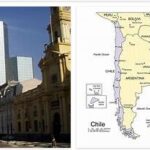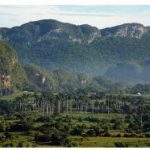Cities and Places in Cuba
Valle de Viñales
In the west of Cuba is the famous tobacco growing region of Cuba – Viñales. The area around the town of the same name is famous for its “mogotes”, rugged, steep limestone cliffs that give the landscape its typical appearance. Since the opening of Cuba to tourism, Viñales has become the most visited place in the province. Viñales is a national monument and has been declared a World Heritage Site by UNESCO, together with the Valle de Viñales and its agricultural cultivation tradition. On a walk in Viñales valley through tobacco plantations you can enjoy the wonderful view and the sight of the limestone formations of the Mogotes, harmoniously protruding from the landscape of the tobacco fields. Near Viñales is the town of Pinar del Río, where everything revolves around tobacco. It is interesting to visit a tobacco plantation and be privy to the secrets of growing tobacco from a farmer.
Bayamo
The second oldest city in Cuba is the capital of the eastern province of Granma and is considered the cradle of nationalism and the starting point of political revolts. Almost all of the city’s important buildings can be found around the Plaza de la Revolución. For example the Hotel Royalton, the House of Culture, the popular assembly “Poder Popular” and the historic Café Pedrito. Other sights are the Plaza del Himno, which was named after the Cuban national anthem, as well as the Parque Maceo Osorio and the Casa Natal de Carlos Manuel de Céspedes. South of the city, steeply sloping to the Caribbean Sea, is the Sierra Maestra mountain range. The Sierra Maestra is the former retreat of the guerrillas around Che Guevara. The tropical green mountain landscape of the Turquino National Park is an excellent hiking area, which has waterfalls and viewpoints to the former rebel headquarters, the “Comandancia de la Plata”. Hidden under the thick canopy of leaves of the rainforest, the Cuban revolution was once planned here.
Trinidad
Trinidad was founded in 1514 by Diego Velázquez de Cuellar. For a long time, the city was one of the richest cities in Cuba due to its supremacy in the sugar and tobacco trade. The cozy colonial city of Trinidad is, along with Old Havana, the largest cohesive ensemble of colonial buildings in Cuba and was declared a World Heritage Site by UNESCO in 1988. Trinidad is a tranquil city that is worth staying there for a long time. In the historic center you can marvel at the well-preserved cobblestone streets, where horses are just as common a sight as cars, and the lovingly renovated colonial buildings with their typical red adobe bricks. There is also Cuban live music. Despite its popularity, Trinidad still has the slightly sleepy charm of a Caribbean fishing town. From Trinidad, a ride out into the prairie to the idyllic Finca Guachinango is popular. You should also take a trip to the nearby beautiful sandy beach of Playa Ancón. Visit weddinginfashion for Cuba Tour Plan.
Havana
The capital Havana was founded by the Spanish in 1519 and became an important trading and naval base. Renaissance and Baroque houses, palaces, monasteries and churches have been preserved from the colonial period. The largest church is the Cathedral of San Cristobál. The Castillo de la Fuerza was built by the Spanish in 1544 and is one of the oldest fortresses in America. Further fortresses were built in the 16th and 18th centuries to secure the port entrance. In addition to the magnificent colonial architecture in La Habana Vieja, the beautiful old town of Havana s, it is the contagious vitality of the lively street life that always fascinates visitors here. Domino players sit on the roadside, the latest salsa hits are booming from open shops, housewives have loud conversations from one balcony to another and street vendors offer their goods for sale. From 1920 many villas were built in Havana by rich Americans who escaped the prohibition on alcohol on the island. The Cubans opened many bars, pubs and restaurants, some of which still exist today, such as Hemingway’s legendary bar “Bodeguita del Medio”. The world metropolis Havana was “frozen” in time in a strange way and that is exactly what attracts the enthusiastic visitors.
Cienfuegos
Cienfuegos is located in an imposing bay in central Cuba and is the capital of the province of the same name. The city of Cienfuegos which used to be a disreputable pirates’ nest, is now an important industrial and port city. Characterized by its stately buildings from the 17th century and because of its attractiveness, it is called the “Pearl of the South”. The bay was first described by Christopher Columbus in 1494. Part of the natural bay is separated as a dolphin pool and there is a great dolphin show. The dolphinarium is located directly on the beach at Playa Rancho Luna. There are several shows every day and there is an opportunity to swim with the dolphins. Also worth seeing are the El Nicho waterfalls, which you can visit on an excursion into the rainforest landscape, and you can also enjoy a small swim in one of the cool and refreshing natural pools. Topes de Collantes is not to be despised.
Baracoa
The small town of Baracoa lies between the fertile Atlantic north coast and the Sierra Maestra mountains. The broad mountain range is the reason for the seclusion of the city; before the revolution, Baracoa was only accessible by sea. For many visitors, the city is the most beautiful place in the country, which impresses with its special originality and Caribbean flair. In recent times, tourism has also developed into an important branch of the economy. But since the city’s remote location prevents mass tourism, Baracoa is the perfect place to relax and enjoy the exotic atmosphere of the picturesque streets with their neat, pastel-colored houses. It is the starting point for excursions to the Humboldt National Park, one of the most famous national parks in Cuba. The national park established with the support of the Frankfurt Tropical Forest Foundation “Oro Verde” is home to many endemic animal and plant species and is considered Cuba’s new showcase project for sustainable tourism. Due to its scenic diversity and the large number of endemic species of flora and fauna, the national park is one of the most important nature reserves in the world. You can also take a boat trip on a “Cayuca” from the city on the Toa River and visit Finca Duaba with its small banana, cocoa and coffee plantations.











